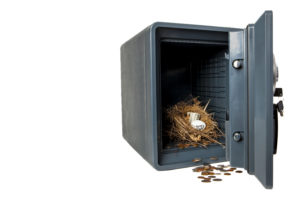Whole life insurance is an asset that provides you with liquidity, tax deferred growth and a solid financial foundation.
When life insurance is used as your own bank, you have a store of wealth that is protected from the ebbs and flows of the market, but the ability to draw upon your money when opportunities arise.
These opportunities create cash flow, or passive income, when you purchase an income generating asset that pays you.
You can then use that passive income to refill your “bank,” and create further opportunities as they are presented to you.
Income Generating Assets
The purpose of an investment is ultimately to make you money.
You might buy a commodity at one price, for instance, hoping that the market value increases and, in the future, you’ll be able to sell at a higher price.
In this case, the reward for making a wise investment is the profit you earn from buying low and selling high. So, until you actually decide to sell, you’re not realizing any additional income.
There’s certainly nothing wrong with this type of investment. But, if your goal is to put together a well-balanced portfolio designed to build long-term wealth, there’s another category of investment you should probably consider: income generating assets.
Income-generating assets are, in a nutshell, investments that provide you with regular cashflow just by owning them.
Your profit reward for making the investment is not limited to appreciation in the asset’s sale value—you also get cold, hard cash on a regular basis.
The resultant cash flow is called “passive income” because you don’t have to do any extra work to earn the money. The income-generating asset does the work for you.
When an asset is income-earning, it adds to your monthly budget, rather than subtracts. A new car is nice, but the monthly loan and insurance payments take away from the cashflow you have available each month.
So, unless you are in the rental car business, a new vehicle is properly thought of as a liability and not an asset.
An income producing asset, on the other hand, increases the cash you have available to spend (or invest) on other things.
Income-earning assets vary in the extent to which they require regular involvement on the part of the owner.
Most financial instruments like CDs require little-to-no effort after purchase. You just buy the asset and then collect the regular interest payments.
On the other side of the spectrum, investment real estate requires a lot more attention, particularly if you’re handling landlord duties personally.
Advantages of Income-Generating Investments
If your goal is to accumulate long-term wealth, a source of consistent income that doesn’t require much or any of your time comes with a considerable opportunity-cost advantage.
Income earned through employment requires a tradeoff—the time you spend working in exchange for the wages you earn.
Time committed to employment is time that can’t be applied toward recreation or earning money elsewhere.
But, if you replace employment income with passive income from an income-generating asset, you free up that time to use as you see fit.
You might decide to continue committing those hours to employment, in which case your cash flow increases and you have more funds to put toward other income-producing assets.
Or you might spend the time fly-fishing or take up sculpting.
The point, though, is that passive income allows you the freedom to do what you want to do because you don’t have to work as much—or at all if your passive income is sufficient to cover all your income needs.
Retirement Planning
Cashflow produced by income-earning assets is especially useful in retirement planning. The regular revenue adds predictability to budgeting and, perhaps more importantly, helps you avoid drawing down principal to pay for regular expenses.
When you have to sell off assets for monthly living expenses, your aggregate wealth decreases each month, and the assets sold for cash are no longer accruing interest or otherwise appreciating in value.
As investment growth decreases, you’re forced to rely more and more on drawdowns of principal until, eventually, little of your savings for retirement is left.
And assets you sell to fund retirement cannot be passed along to your heirs.
On the other hand, an asset that provides consistent income of its own adds to the cash available for budgeting without reducing your overall wealth.
Cash Flow
And even as an income-generating asset produces regular cashflow, its inherent value might also increase.
Think of a rental property. Monthly rent payments from tenants add to your budget, and, at the same time, the value of the property may also be increasing (depending on the real estate market).
The rental property gives you the opportunity to increase aggregate wealth in two different ways.
First, by providing cash to cover expenses and invest in other assets—and also based on any appreciation in the inherent value of the property.
Passive income earned from income-generating investments is taxable income you need to report on your tax return.
However, many of the expenses associated with maintaining an income-producing asset can be deducted, and some passive income receives favorable tax treatment (such as dividends, which are usually taxed at a lower rate than income from employment).
Returning to our rental property example, regular rent payments you receive from a tenant count as taxable income.
But amounts expended in maintaining and managing the property—including a property management company’s fee—are often deductible.
The Best Income Earning Assets
There are a wide variety of investments that can produce passive income. Even most savings accounts and CDs technically qualify as income-earning if they pay out regular interest.
Of course, savings accounts and CDs have very low interest rates—particularly in the current low-rate environment—so the amount of passive income generated is small unless you put in a tremendously large principal.
Even so, savings accounts and CDs are both FDIC insured, so there’s essentially no risk of losing money.
But savings account and CDs aren’t really the kind of income-generating assets we’re talking about here. We’re more interested in the types of assets that have the potential to produce enough passive income to make a considerable contribution toward long-term wealth building.
Cash Value Life Insurance
Some of the most consistent dividend-issuing entities are mutual life insurance companies.
But, instead of a corporation divvying up profits among stockholders, a mutual life insurance company pays out part of its earnings to its policyholders via participating whole life insurance.
The policyholders are technically the company’s owners, and they purchase interests in the company by paying premiums.
Life insurance dividends are paid throughout the life of a policy, with dividend payments linked to the amount of premium invested.
Along with dividends, many cash value life insurance policies also earn regular growth in the form of guaranteed interest payments.
Not all policies pay dividends, but most permanent policies accrue cash value that earns interest in one form or another.
Whole life insurance is usually a long-term investment. However, policyholders who have maintained a policy for twenty or thirty years see respectable ROI with no risk of loss. And if you should die too early, a leveraged death benefit creates a huge boon for your beneficiaries.
A well-designed cash value life insurance policy is timed so that cash-value reaches the point where it can provide a supplemental income stream through withdrawals or an annuitized payout just in time for retirement.
And, of course, until you reach that point, you get the benefit of the life insurance itself, providing a safety net for loved ones in the event of the insured’s untimely death.
Annuities
An annuity is a contract you enter into with a life insurance company in which you pay a large upfront premium to the company, and it in turn makes regular payments to you for the rest of your life (or for a defined number of years—depending on the annuity).
Lifetime annuities are great for retirees because they provide a hedge against “longevity risk,” the risk that your lifespan goes on longer than your retirement savings.
You’re basically buying a private, guaranteed lifetime pension.
The consistent income is a big advantage in budgeting, freeing up other resources for less-liquid or more long-term investments.
Annuities can be purchased in a variety of ways—from legal settlements, a lump-sum severance payment upon retirement, or with IRA or 401k funds, for example.
A popular and effective approach for retirement planning is to take the no longer needed cash value life insurance policy and exchange it for a lifetime annuity when you retire via a 1035 exchange.
An asset that previously protected your family against disaster becomes a guaranteed source of passive income throughout your entire retirement.
Importantly, the premium you pay when you purchase an annuity earns interest while the insurance company is holding it. So, you’re not just getting back the money you paid in; you’re earning ROI in the process.
And, with a lifetime annuity, you’re betting on yourself. The longer you live, the more return you will see on your premium investment.
Annuities also come with a diverse range of optional riders that can be used to tailor the annuity contract to the individual needs of the annuitant.
Investment Real Estate
Investment real estate, in general, is real property you purchase for the purpose of making money, as opposed to occupying yourself. When you buy an investment property, you’re usually not planning to use it as your long-term primary residence or to house your business.
For the most part, steady passive income produced from an investment property comes in the form of rent payments from a tenant.
Income-generating investment real estate can be anything from a small condo or townhouse you rent to a single family to a large commercial building with dozens or more tenants.
Ideally, the regular rent payments will be sufficient to offset any mortgage payments due on the property, insurance, property taxes and utilities, and the costs of maintenance and upkeep—hopefully with a decent amount left over as income.
As noted above, return on investment (ROI) can come in the form of not just rent payments, but also appreciation in the real estate’s value, though the latter doesn’t produce steady income.
The most commonly cited downside of real estate as an income-producing investment is that acting as a landlord can sometimes be a hassle.
With residential real estate especially, state landlord-tenant laws often impose considerable duties on landlords.
However, most upkeep and lessor responsibilities can be delegated to a property management company for a fee, though the fee will affect the property’s overall profitability.
Some other types of real estate investments are also available, that are more passive in nature.
Turn Key Investments
Turn Key Real Estate
Many companies take the hassle out of owning real estate by providing turn key real estate.
Turn key real estate is real estate that is available to the buyer with very little, to any work.
Farmland
Companies such as AcreTrader allow you to invest in farm land. Farmland is real estate that produces a commodity (a crop). And the good news is farmland is relatively non-correlated to other investment assets.
Another company, Harvest Returns, allows you to choose form among many different types of agriculture investments.
Some of the different income generating assets to choose from include:
- Coffee Farms
- Cocoa Farms
- Cattle Farms
- Bamboo Farms
- Hemp Farms
Stocks in Dividend Paying Companies
A dividend is a portion of a company’s earnings paid out to stockholders, usually at the election of the board of directors or corporate officers on a fairly consistent schedule.
The company is basically saying, “we earned this much money in the quarter and are going to distribute part of that to stockholders as dividends.”
Stockholders then receive dividend payments based upon the number of shares they own in the company.
Not all stocks produce dividends, and not all of those that do pay them consistently—especially when earnings are down.
As a general guideline, larger and more well-established companies tend to pay consistent dividends much more regularly than small companies and companies focused on growth.
Some mutual funds are also set up to pay regular dividends, with amounts based on the dividends paid to the fund by the corporations in which the fund is invested.
Mutual funds can be a great way to secure dependable passive income from dividends.
Diversity in the fund’s investments helps mitigate the risk of any one company having a bad earnings period.
Financial Freedom
The key to long-term financial independence is to own sufficient income-earning assets to completely cover the costs of your regular expenses.
If you have enough passive income to handle all of your monthly costs of living, you’re free to work on other things, or not work at all.
And you have more flexibility to make other investments without fear of needing to cash out in a hurry to cover bills.



